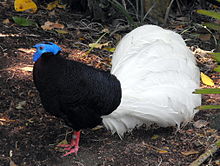Pheasant-like
| Pheasant-like | ||||||||||
|---|---|---|---|---|---|---|---|---|---|---|
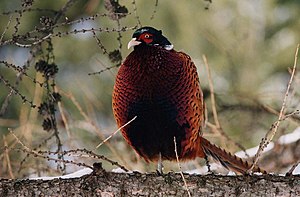
Pheasant ( Phasianus colchicus ) |
||||||||||
| Systematics | ||||||||||
|
||||||||||
| Scientific name | ||||||||||
| Phasianidae | ||||||||||
| Horsfield , 1821 |
The pheasant-like (Phasianidae) are by far the largest chicken family . 175 species are included here, including not only the actual pheasants, but also such well-known birds as the bankiva chicken (with its domesticated form, the domestic chicken ), the partridge , the quail , the turkey , the capercaillie and the peacock .
features
In their morphology and their behavior, the members of the pheasant-like are very different, but matching skeletal features indicate that they belong together as a group. They are all ground-dwelling birds with plump bodies, short bills and short necks. Most of the time, the wings and tails are also very short, but there are notable exceptions such as some pheasants and especially the peacocks. All pheasants are able to fly. Most of the time, however, only short distances are covered.
The size lies in a range between 12 cm (dwarf quail) and 230 cm (Indian peacock), the weight between 20 g (dwarf quail) and 10 kg (turkey).
A common feature of all pheasant-like species are the spores of the males, which attach to the tarsometatarsus . Pheasant-like share this characteristic with the guinea fowl . There is usually one spur per leg, but some species have more. The peacock pheasants can have up to seven spores, hence their scientific name Polyplectron . In the spur hen ( Galloperdix ) the females also have a spur. The spur can be used as a weapon in a fight with rival males, but it also plays a role in courtship as a feature that favors a female's decision.

Many pheasant species wear eye-catching ornaments such as bonnets, throat pouches and bare facial skin. A sexual dimorphism does not exist in all species, but if it occurs, it is often spectacular. The females then mainly wear gray and brown colors, the males bright colors. Usually males are at least slightly, sometimes significantly, larger than females. With the quail ( Coturnix ) the ratio is reversed, here the females are slightly larger.
distribution and habitat
Pheasant-like species are found almost all over the world. The distribution area includes Eurasia, Africa, North and Central America, Australia and the Arctic. However, they are missing in South America, in Antarctica and on some oceanic islands. However, the distribution is not even. The focus of the family is in Southeast Asia with an extraordinary biodiversity. There are also many species in South and West Asia as well as in Africa, whereas Europe, America and Australia are only populated by very few species.
The grouse inhabit the Arctic and the northern temperate zones of the world. The two species of turkeys live in North and Central America. The species formerly known as partridges are common in Eurasia and Africa; With the quail there are also some Australian species in this group, and the pearl quail ( Margaroperdix madagarensis ) is the only pheasant-like bird that inhabits Madagascar .
The pheasants are originally found exclusively in Asia, especially in Southeast and East Asia. The “real” pheasant ( Phasianus colchicus ) was introduced in Europe, North America and New Zealand. The tragopans, peacock pheasants and peacocks are also restricted to tropical Asia, with the exception of the Congo peacock ( Afropavo congensis ) from central Africa.
Most pheasants are resident birds .
All habitats on earth serve as habitats for pheasant species. Most species inhabit tropical rainforests , but savannas, deserts, the polar regions and man-made fields are also inhabited by pheasants. In the mountains, the Tibetan king chicken ( Tetraogallus tibetanus ) rises up to 5800 m.
Way of life
All pheasants are diurnal birds. As a rule, forest-dwelling species are solitary, while the species live in groups in open areas. These can include up to 20 individuals in the Frankolines ( Francolinus ). These groups disintegrate during the breeding season.
food
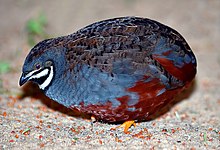
Hardly anything can be said in general about nutrition. All sorts of plant matter such as seeds, leaves, flowers, twigs, buds and roots are eaten, as well as numerous invertebrates, exceptionally small vertebrates up to the size of a lizard.
As a rule, the young birds are insectivores, while the adults are predominantly herbivores. In their first week of life, partridge chicks feed on insects to 95%, while the proportion of animal food in adult birds is only 16%. There are only a few species among the pheasant-like species that are exclusively herbivores as adult birds - these include, for example, the stockpile grouse ( Lerwa lerwa ) and some representatives of the grouse. Some species of the rainforest also eat mainly insects as adult birds, but none of them exclusively.
The foraging for food takes place mostly on the ground, exceptions are the tragopane and the blood pheasant, which mainly go for food in the trees.
Reproduction
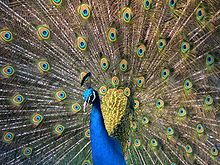
The young birds of the pheasant-like birds are like those of all chickens who flee their nest and do not require intensive brood care . For this reason, one parent is enough to guard the boys. The female takes on this task, while the male has nothing to do with rearing young and mostly with the brood.
The mating behavior varies greatly. Among the partridges and relatives one finds a monogamous seasonal marriage, in which the rooster usually stays together with only one hen for the duration of a breeding season. Many pheasants, on the other hand, are polygamous . The males of some species such as those of the tragopane seek out several females one after the other during a breeding season and mate them. In other species, such as the pheasant, the cocks gather a harem of several hens around them. Courtship, mating and later the hen breeding business take place separately from the harem.
With black grouse , prairie chickens and peacocks , several males gather in an arena ( lek ) to present themselves to the females. The female then selects a partner. The courtship is similar in capercaillie and argus pheasant , which, however, do not know any leks, but instead advertise individually for females. All of these species are polygynous , which means that after mating, the males continue their efforts to find more mates.
The nest is almost always built on the ground, only that of the tragopane in trees. In the open area it is protected by bushes or rocks. The size of the clutch is very different, it ranges from one egg like the Malay mirror peacock to 20 eggs from the partridge . They are incubated between 14 days like the harlequin quail and around a month like the blue peacock .
Systematics
External system
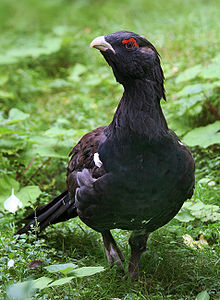
The pheasant-like are a family within the order of Galliformes (Galliformes). Their exact composition changed again and again. Sometimes the grouse and turkey were run as separate families outside of the pheasant-like family, sometimes toothed quail and guinea fowl were counted among the pheasant-like species.
Today it is customary to group the grouse, partridge, turkey, pheasant and peacock as pheasant-like. In this combination, the pheasant-like species are most likely a monophyletic group. With the toothed quail (Odontophoridae) and the guinea fowl (Numididae) they can be united to form a suborder Galli, which are opposed to the Hokkohenner (Cracidae) and the big foot fowl (Megapodiidae).
However, the relative position of the guinea fowl and tooth quail to the pheasant-like remains unclear. Based on the molecular clock , a separation of the pheasant and guinea fowl is suspected 37 million years ago ( Eocene ).
Internal system
A traditional division divides the pheasant-like into the following subfamilies:
- Grouse (Tetraoninae)
- Partridge (Perdicinae)
- Turkeys (Meleagridinae)
- Satyr chickens (Tragopaninae)
- Peacock Pheasants (Argusianinae)
- Asiatic peafowl (Pavoninae)
- Congo peacocks (Afropavoninae)
- Pheasants (Phasianinae)
The pheasants include the bankiva chicken ( Gallus gallus ), the ancestral form of the domestic chicken . Later systematics regarded the peacocks, peacock pheasants and tragopanes as specialized pheasants, so that ultimately four subfamilies remained: the grouse, the turkey, the partridge and the pheasant.
However, modern analyzes have led to the conclusion that these classifications are all untenable. In the following, the system according to Winkler and colleagues, based on various phylogenetic studies, is presented.
- Subfamily Arborophilinae or Rollulinae
 Strauss quail ( Rollulus rouloul )
Strauss quail ( Rollulus rouloul )- Wood partridge ( Arborophila ), 18 species in Southeast Asia
- Eye quail ( Caloperdix oculea ), Southeast Asia
- Spurge ( Galloperdix ), three species in Nepal , India and Sri Lanka
- Red-headed quail ( Haematortyx sanguiniceps ), Borneo
- Black quail ( Melanoperdix nigra ), Southeast Asia
- Rhizothera , two species: long-billed quail ( Rhizothera longirostris ) and dulit quail ( Rhizotera dulitensis ), both from Southeast Asia
- Crested Partridge ( Rollulus rouloul ), Southeast Asia
- Xenoperdix , the genus that was only described in 1994, comprises two species: Udzungwawachtel ( Xenoperdix udzungwensis ) and Rubehowachtel ( Xenoperdix obscurata ), both Tanzania
- Subfamily Phasianinae
- Tribus Pavonini
- Congo peacock ( Afropavo congensis ), Central Africa
- Argus Pheasant ( Argusianus argus ), Southeast Asia
- Asian peafowl ( Pavo ), two species in South and Southeast Asia, namely blue peacock ( P. cristatus ) and eared peacock ( P. muticus )
- Pearl peacock ( Rheinardia ocellata ), Southeast Asia
- Tribus Polyplectronini
- Pfaufasanen ( Polyplectron ), seven species in Southeast Asia
- Tribe Coturnicini
 Pternistis is the most species-rich genus of the pheasant-like; here: yellow-throated frankolin ( Pternistis leucoscepus )
Pternistis is the most species-rich genus of the pheasant-like; here: yellow-throated frankolin ( Pternistis leucoscepus )- Stone fowl ( Alectoris ), seven species in Southern Europe, North Africa, West and Central Asia, u. a. the Alpenstein chicken ( A. graeca ), the chukar ( A. chukar ), the red-legged partridge ( A. rufa ) and the rock chicken ( A. Barbara )
- Desert chicken ( Ammoperdix ), two species native to western Asia and northeast Africa
- Snow Mountain Quail ( Anurophasis monorthonyx ), New Guinea
- Quail ( Coturnix ), eight species found in Eurasia, Africa and Australia
- Haldenhuhn ( Lerwa lerwa ), Himalaya
- Pearl quail ( Margaroperdix madagarensis ), Madagascar
- Himalayan quail ( Ophrysia superciliosa ), Himalaya
- Frankolin quail ( Perdicula ), four species in India , Bangladesh , Sri Lanka
- Pternistis (23 species), "Frankoline"
- King fowl ( Tetraogallus ), five species in the mountains of West and Central Asia, u. a. the Caucasian king chicken ( T. caucasiscus )
-
King quail ( Excalfactoria )
- Dwarf quail ( Excalfactoria chinensis )
- Adanson quail ( Excalfactoria adansonii )
- Tribus Gallini
 Ceylon chicken ( Gallus lafayettii )
Ceylon chicken ( Gallus lafayettii )- Bamboo chickens ( Bambusicola ), two species native to East and Southeast Asia
- Schopffrankolin ( Dendroperdix sephaena ) (1 species), "Frankoline"
- Francolinus (5 species), "Frankoline"
- Peliperdix (4 species), "Frankoline"
- Scleroptila (7 species), "Frankoline"
- Comb chickens ( Gallus ), four species in South and Southeast Asia, u. a. the bankiva chicken ( G. gallus )
- Tribe Lophophorini
 Himalayan pheasant ( Lophophorus impejanus )
Himalayan pheasant ( Lophophorus impejanus )- Blood Pheasant ( Ithaginis cruentus ), Central Asia
- Glossy Pheasant ( Lophophorus ), three species in Central Asia
- Wedge-tailed chickens ( Tetraophasis ), two species in southwest China
- Tragopane ( Tragopan ), five species in Central and East Asia
- Phasianini tribeBulwer's Pheasant ( Lophura bulweri )
- Wallichfasan ( Catreus wallichii ), Himalaya
- Collared pheasants ( Chrysolophus ), two species in East Asia, namely golden pheasant ( C. pictus ) and amherst pheasant ( C. amherstiae )
- Ear pheasants ( Crossoptilon ), three species in East Asia
- Chicken Pheasants ( Lophura ), ten species in South and Southeast Asia, u. a. the fire-backed pheasant ( L. ignita )
- Partridges ( Perdix ), three species in Europe and Central Asia, u. a. the real partridge ( P. perdix )
- Noble Pheasants ( Phasianus ), two species in Asia, also naturalized in Europe, North America and New Zealand; u. a. the real pheasant ( P. colchicus ) and the green pheasant ( P. versicolor )
- Schopf pheasant ( Pucrasia macrolopha ), East
- Black- tailed pheasant ( Syrmaticus ), five species in East Asia, u. a. the mikado pheasant ( S. mikado )
- Tribe Tetraonini
 Ptarmigan ( Lagopus muta )
Ptarmigan ( Lagopus muta )- Chicken collar ( Bonasa umbellus ), North America
- Mugwort ( Centrocercus ), two species in North America, u. a. the mugwort ( C. urophasianus )
-
Rock mountain fowl ( Dendragapus ), two species found in North America
- Douglas fir grouse ( Dendragapus obscurus )
- Coast grouse ( Dendragapus fuliginosus )
- Falcipennis ( Falcipennis ), two types in North America and Eastern Siberia, namely the sickle chicken ( F. Falcipennis ) and the fir chicken ( F. canadensis )
- Ptarmigan ( Lagopus ), three species in the Arctic and in the mountains of the northern hemisphere, u. a. the red grouse ( L. lagopus ) and the ptarmigan ( L. muta )
- Black grouse ( Lyrurus ), two species in Europe and North Asia, u. a. the black grouse ( L. tetrix )
- Turkeys ( Meleagris ), two species found in North and Central America, namely the turkey ( M. gallopavo ) and the peacock turkey ( M. ocellata )
- Capercaillies ( Tetrao ), two species in Europe and North Asia, u. a. the capercaillie ( T. urogallus )
- Hazel grouse ( Tetrastes ), two species in Europe and North Asia, u. a. the hazel grouse ( T. bonasia )
- Prairie chickens ( Tympanuchus ), two species in North America, u. a. the prairie chicken ( T. cupido )
- Tribus Pavonini
Pheasants and humans
Has always Gamebird are a wild game . They played an important role early on as food, especially for people in Southeast Asia and Africa. Pheasants, partridges and quails were also hunted in Europe and kept on the menu.
The most important species for humans is undoubtedly the bankiva chicken with its domesticated form, the domestic chicken . It is now believed that domestication occurred several times independently of one another in India and Southeast Asia. In Southeast Asia it took place before 6000 BC. BC, from where domestic chickens first came north to China. Not until 1500 BC The domestic chicken reached the Mediterranean area. Since it was already widespread in Central Europe in the Bronze Age, it is assumed that it had spread from China to Europe via the Russian steppes. The domestic chicken reached many oceanic islands early on through Malay and Chinese seafarers. Polynesian settlers brought the first domestic chickens to the Americas even before the arrival of Christopher Columbus .
The turkey was also domesticated by humans. This was achieved in the southwest of today's USA and in northern Mexico between 500 and 700. The conquistador Hernán Cortés then brought the first domestic turkeys from America to Europe.
Some pheasant-like birds are kept as park and aviary birds mainly because of their splendor of color. The pheasant industry has its origins in China. Although the blue peacock comes from India, it was brought to Egypt and Greece in ancient times. It was held at the court of the pharaohs and flowed into Greek mythology. In Roman times and in the Middle Ages, peacocks were considered a delicacy on the tables of the rich and noble.
The actual pheasant was brought as hunting game by humans to numerous areas of the world in which it was not originally native. Its actual distribution area reached from the Caucasus through Central Asia to China. Since the Romans made it at home in Europe, it is considered an archaeozoon . Later humans also brought him to North America, Tasmania and New Zealand. Other pheasant species such as the golden pheasant and the Amherst pheasant were also introduced locally in Europe, but by no means with as great success as the actual pheasant.
swell
literature
- Josep del Hoyo et al .: Handbook of the Birds of the World. Volume 2: New World Vultures to Guinea Fowl. Lynx Edicions, 1994, ISBN 84-87334-15-6 .
- Steve Madge , Phil McGowan , Guy M. Kirwan : Pheasants, Partridges and Grouse. A Guide to the Pheasants, Partridges, Quails, Grouse, Guineafowl, Buttonquails and Sandgrouse of the world. Christopher Helm, London 2002, ISBN 0-7136-3966-0 .
- Heinz-Sigurd Raethel : Chicken birds of the world. Verlag J. Neumann-Neudamm GmbH & Co. KG, Melsungen 1988, ISBN 3-7888-0440-8 .
Sources cited
Most of the information in this article has been taken from the sources given under literature; the following sources are also cited:
- ↑ a b Bernhard Grzimek (Ed.): Grzimeks Tierleben. Volume 7/8: Birds 1/2. dtv-Verlag, 1979.
- ↑ a b Derek E. Dimcheffa, Sergei V. Drovetskib & David P. Mindell: Phylogeny of Tetraoninae and other galliform birds using mitochondrial 12S and ND2 genes. In: Molecular Phylogenetics and Evolution. Volume 24, No. 2, 2002, pp. 203-215.
- ↑ The toothed quail and guinea fowl, which in Grzimek's animal life were classified as pheasant-like, have been removed from this systematic overview
- ^ ITIS , accessed October 18, 2008
- ^ A b David W. Winkler, Shawn M. Billerman, Irby J. Lovette: Bird Families of the World, A Guide to the Spectacular Diversity of Birds. Lynx Edicions Publications, 2016, ISBN 978-84-941892-0-3 , pp. 52-55.
- ↑ Rebecca T. Kimball, Colette M. St. Mary, Edward L. Braun: A Macroevolutionary Perspective on Multiple Sexual Traits in the Phasianidae (Galliformes). In: International Journal of Evolutionary Biology. Volume 2011, Article ID 423938, doi: 10.4061 / 2011/423938 .
- ↑ Soo Hyung Eo, Olaf RP Bininda-Emonds, John P. Carroll: A phylogenetic supertree of the fowls (Galloanserae, Aves). In: Zoologica Scripta. Volume 38, No. 5, 2009, pp. 465-481, doi: 10.1111 / j.1463-6409.2008.00382.x .
- ↑ a b Ning Wang, Rebecca T. Kimball, Edward L. Brown, Bin Liang, Zhang Zhengwang: Assessing Phylogenetic Relationships among Galliformes: A Multi Gene Phylogeny with Expanded taxon sampling in Phasianidae. 2013, doi: 10.1371 / journal.pone.0064312 .
- ↑ Yi-Ping Liu, Gui-Sheng Wu, Yong-Gang Yao, Yong-Wang Miao, Gordon Luikart, Mumtaz Baig, Albano Beja-Pereira, Zhao-Li Ding, Malliya Gounder Palanichamy & Ya-Ping Zhang: Multiple maternal origins of chickens: Out of the Asian jungles. In: Molecular Phylogenetics and Evolution. Volume 38, No. 1, 2006, pp. 12-19.
- ↑ a b Barbara West & Ben-Xiong Zhou: Did chickens go north? New evidence for domestication. In: World's Poultry Science Journal Volume 45, No. 3, 1989, pp. 205-218.


